Kubernetes Statistics By Market Share, Technologies And Facts (2025)
Updated · Jul 02, 2025
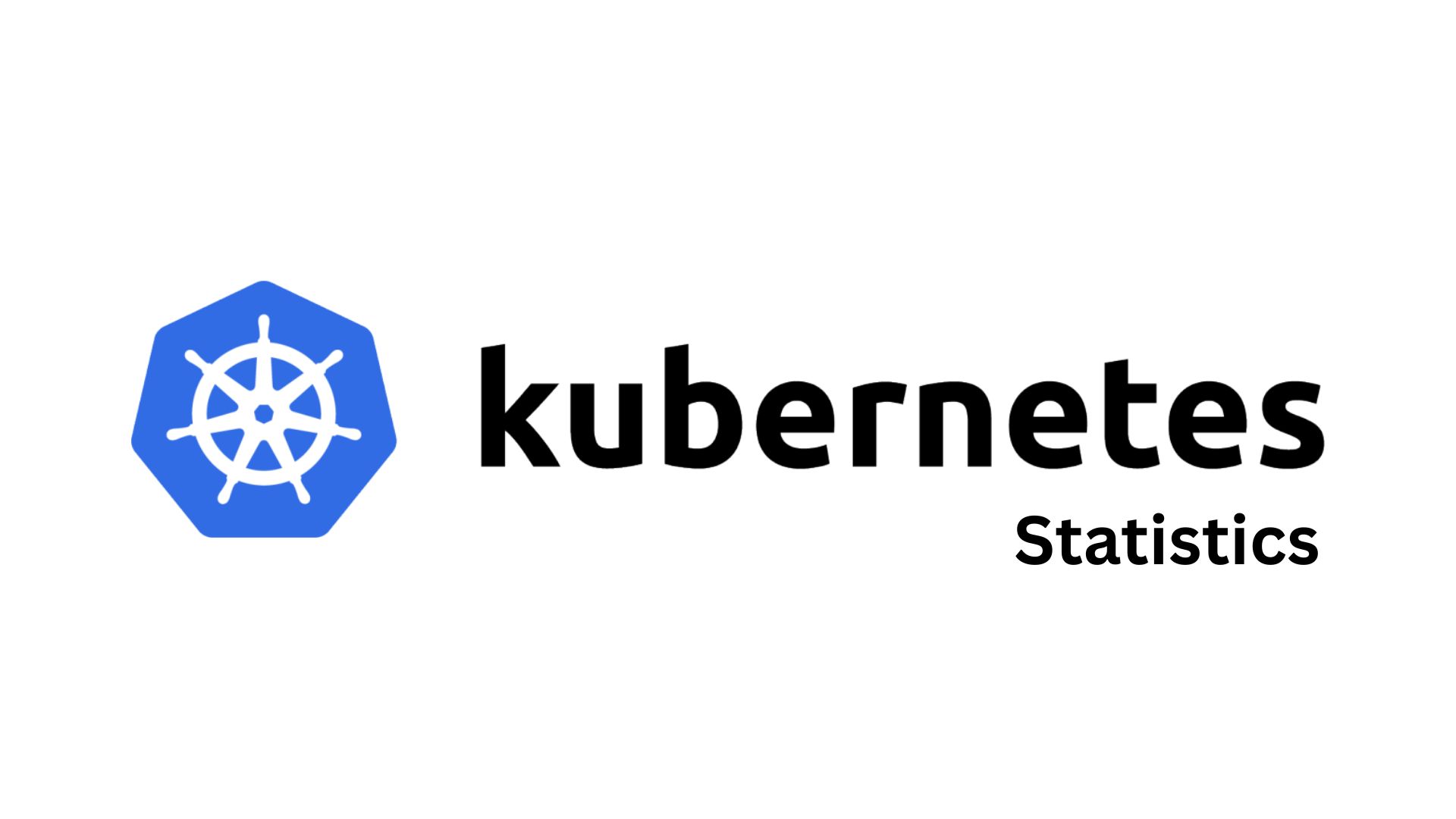
Table of Contents
Introduction
Kubernetes Statistics: Kubernetes, an open-source platform for containerized application deployment, scaling, and management, has become a cornerstone of modern IT infrastructure. As of 2024, over 60% of enterprises have adopted Kubernetes, with projections indicating this number will exceed 90% by 2027.
The United States leads in adoption, with 52.4% of organizations utilizing Kubernetes, followed by the United Kingdom at 3,804 companies and India at 3,627 companies. This widespread adoption reflects Kubernetes’ critical role in enabling scalable and efficient cloud-native operations. The platform’s flexibility and robust ecosystem have made it a preferred choice for managing complex, distributed applications across various industries.
As Kubernetes continues to evolve, its impact on enterprise IT strategies and digital transformation initiatives remains profound. Here are all the latest Kubernetes statistics and trends shaping the landscape in 2024.
Editor’s Choice
- Kubernetes is adopted worldwide, with the United States hosting 52.4% of users and strong adoption from countries like India, Germany, and the UK.
- 91% of enterprises running Kubernetes are from organisations with over 1,000 employees, indicating that large and mid-sized companies dominate the usage landscape of Kubernetes.
- At the valuation of US$1.46 billion back in 2021, Kubernetes grew to US$1.8 billion in 2022 and is forecasted to reach US$9.69 billion by 2031, indicating strong market momentum.
- In terms of the market size, Kubernetes security solutions had a market size of US$1.195 billion in 2022 and are expected to grow at a CAGR of 27.6%, reaching US$10.7 billion by 2031.
- 39% of the Kubernetes decision-makers are directors and managers, while 20% are C-level executives, making them all very strategic.
- Platform engineers (at 21%) and storage/database administrators (at 19%) are also important in implementing and maintaining Kubernetes.
- Kubernetes educational programs are undergoing a boom: while the Kubernetes MOOC attained 290,000 enrollments (up by 25%), the CKA examination hit 104,000 (49% increase), and for the CKAD, it was over 49,000 (44% increase).
- Kubernetes security challenges rise: In 2022, 10% of companies disabled those Linux capabilities considered risky (42% in 2021), and 44% of firms run more than 71% of their workloads as root.
- 62% of organisations consider half or more of their workloads currently vulnerable to image-related issues.
- 46% of the companies use deprecated Helm charts in at least half of their workloads, opposed to 33% the previous year.
- 90% of cloud privileges granted are unused, which is a clear indication of mismanagement of security and access controls.
General Facts
- Kubernetes, or K8s, stems from an internal Google code for data centre management, publicly released in 2014, and subsequently handed over to the Cloud Native Computing Foundation.
- Kubernetes helps with the automation applied to cloud deployment, manages containers for the complete lifecycle, from simultaneously scheduling containers and making sure they are running in clusters.
- Kubernetes finds great usage for cloud web hosting, HPC (high-performance computing), outsourcing data centre operations, and supporting SaaS applications.
- Businesses tend to use Kubernetes for faster software delivery and better revenue generation, as the platform efficiently manages the microservices architecture.
- For many, Kubernetes is a linchpin within the broader cloud-native application strategies.
- The companies are expanding their technical teams to fully exploit the range of functionalities available with Kubernetes.
- Among the very big providers that offer managed Kubernetes solutions are AWS, Microsoft Azure, Google Cloud, and VMware, easing business adoption and deployment.
- Some of these providers dominate the global Kubernetes environment market, with smaller shares afforded to other vendors.
Kubernetes Global Customers
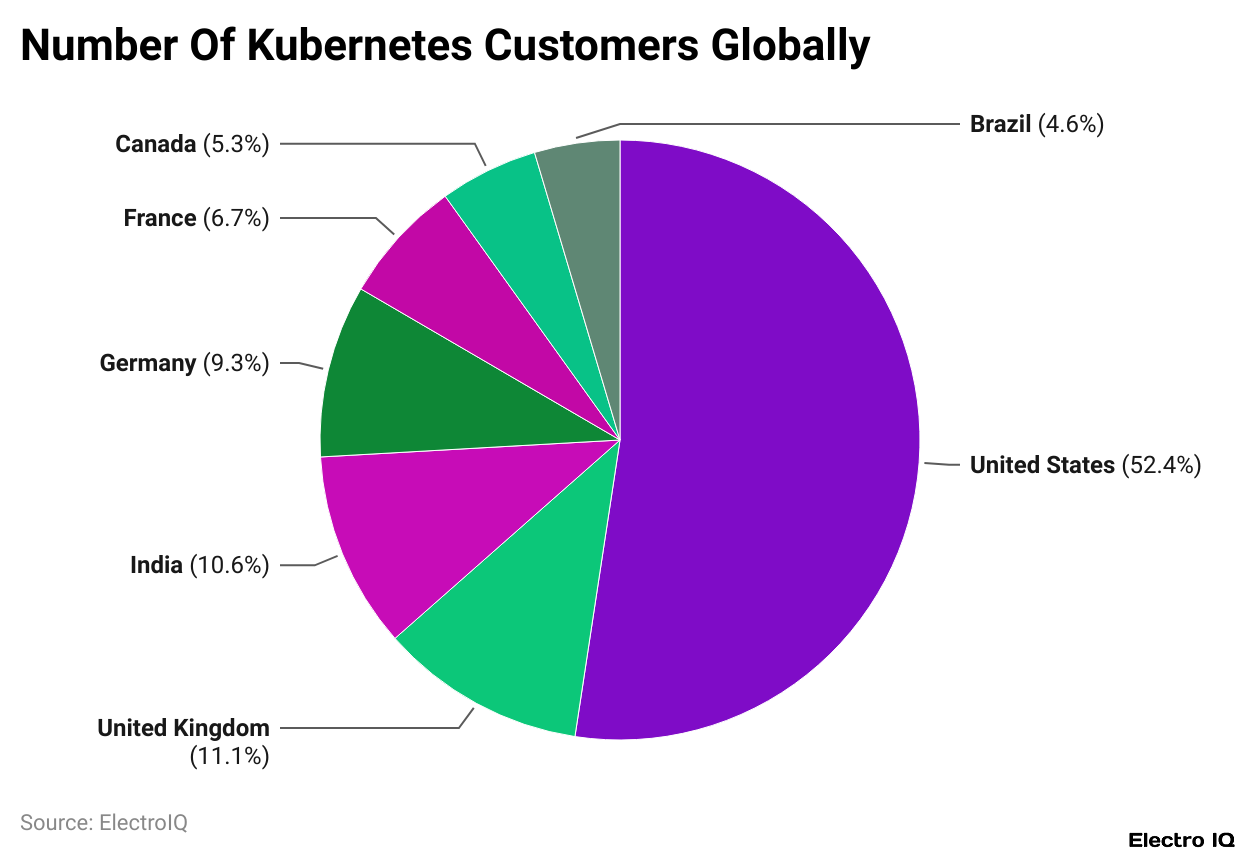
(Reference: edgedelta.com)
- Kubernetes statistics data provided by edgedelta.com, one can conclude that Kubernetes’ worldwide presence is strong, with the U.S. being the largest user country with a 52.4% share of its client-side.
- This means that over half of those who use Kubernetes are U.S.-based, indicating a tremendous dependence on the platform within the region. However, adoption is not just limited to the U.S.
- There are countries like Brazil, Canada, France, Germany, India, and the UK that each constitute between 4.6% and 11.1% of the worldwide user base.
- This spread highlights Kubernetes’ international appeal and confirms the weight it holds across modern IT infrastructure across a wide range of countries.
- Its so widespread across a variety of continents shows that organisations everywhere regard Kubernetes as a worthy tool in managing and scaling their applications.
Kubernetes Company Size
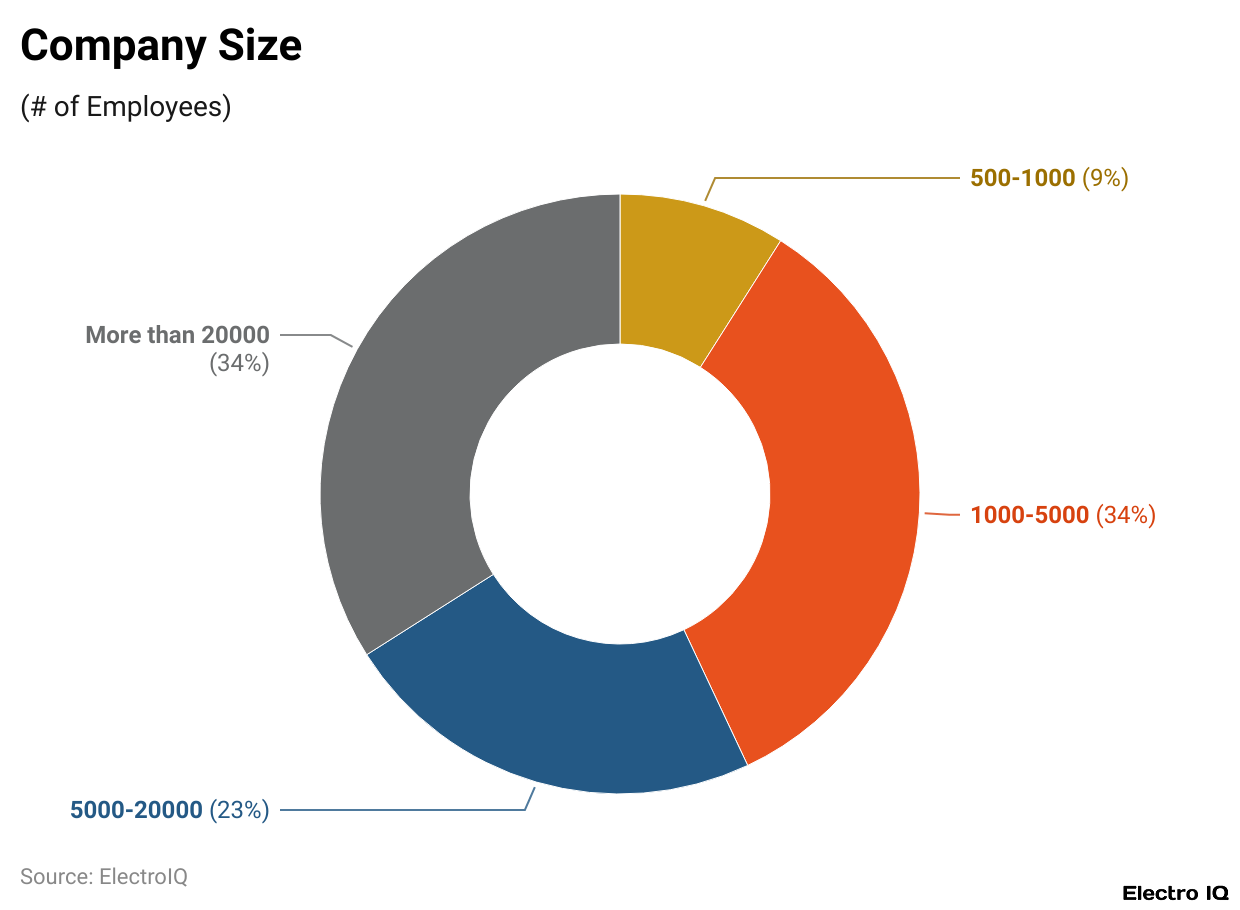
(Reference: portworx.com)
- Based on Kubernetes statistics given by portworx.com, the data reflects that Kubernetes adoption by company size reveals how companies at varying scales are leveraging the platform.
- Larger companies, defined as those having more than 20,000 personnel, consist of 34% of Kubernetes users.
- This points to the fact that large enterprises, which usually have complex IT landscapes, therefore, have a greater need for scalable and automated solutions, and are among the heaviest adopters.
- These types of organisations operate globally and further require strong systems to manage thousands of microservices and applications, which makes Kubernetes a viable option there.
- Also, those with 1,000-5,000 staff levels represent another 34%, pointing to the fact that organisations on the medium-to-large end of the spectrum are furiously investing in Kubernetes.
- Not global-scale giants, of course, but big enough to have tech environments that flex their fingers with Kubernetes flexibility and automation.
- Organisations with 5,000 to 20,000 employees make up 23% of Kubernetes users.
- Likely, their growth phase makes them eager to use Kubernetes to modernise their infrastructure, enhance application performance, and act as an enabler of DevOps- at least their adoption rate indicates strong confidence in Kubernetes as a truly scalable solution supporting their needs for expansion. Then, on the other end of the spectrum, companies with 500 to 1,000 employees constitute just 9% of the population.
- The smaller numbers, in contrast to the other groups, still give a meaningful insight into adoption by mid-sized firms beginning to scale their tech operations and move toward cloud-native solutions.
- Their lower numbers might be explained by the constraint in resources or less infrastructure orchestration, which may delay or altogether diminish the need for Kubernetes when compared to larger organisations.
- The overall distribution pattern shows the most widespread adoption of Kubernetes among large and medium-sized enterprises, with the majority (91%) of its users coming from incumbent organisations having over 1,000 employees.
- Further Kubernetes statistics highlight that Kubernetes strongly aligns itself with organisations endowed with critical technical ability and scale to derive maximum benefit from it.

(Source: edgedelta.com)
- With rising demand for container orchestration solutions among various industries, Kubernetes has witnessed quick upticks both in market value and adoption.
- The platform had been valued at USD 1.46 billion in 2021, clearly testifying to its significant presence in the cloud-native ecosystem.
- Just within a year, it was worth USD 1.8 billion at the end of 2022, a fast pace that only proves that Kubernetes has become imperative for businesses the world over, especially with the fast-tracking shift of organisations to cloud environments and their subsequent adoption of microservices architectures.
- The increasing valuation of containers and Kubernetes-specific security solutions also contributes greatly to Kubernetes growth stores.
- According to Kubernetes statistics reports, the security market alone stood at just under USD 1,195.10 million in 2022.
- This particular sector is generating a lot of bargaining power, so much so that a heavy compound annual growth rate (CAGR) of 27.60% is projected during 2023-31.
- If this growth rate sustains the forecast period, the Kubernetes statistics market will nearly touch USD 10.7 billion. This implies an increase in the use of Kubernetes and rising awareness towards the security aspects associated with running containerised applications at scale.
- Looking a bit further down the horizon, the overall value of the Kubernetes market is projected to reach USD 9.69 billion by 2031, as per industry forecasts.
- This long-term growth prospect thus proves how essential the platform will become to application deployment and orchestration management.
- With evolving technologies and more companies working on automation, scalability, and security, Kubernetes is going to be the cornerstone of the IT infrastructure of tomorrow.
Kubernetes Role Of Employees
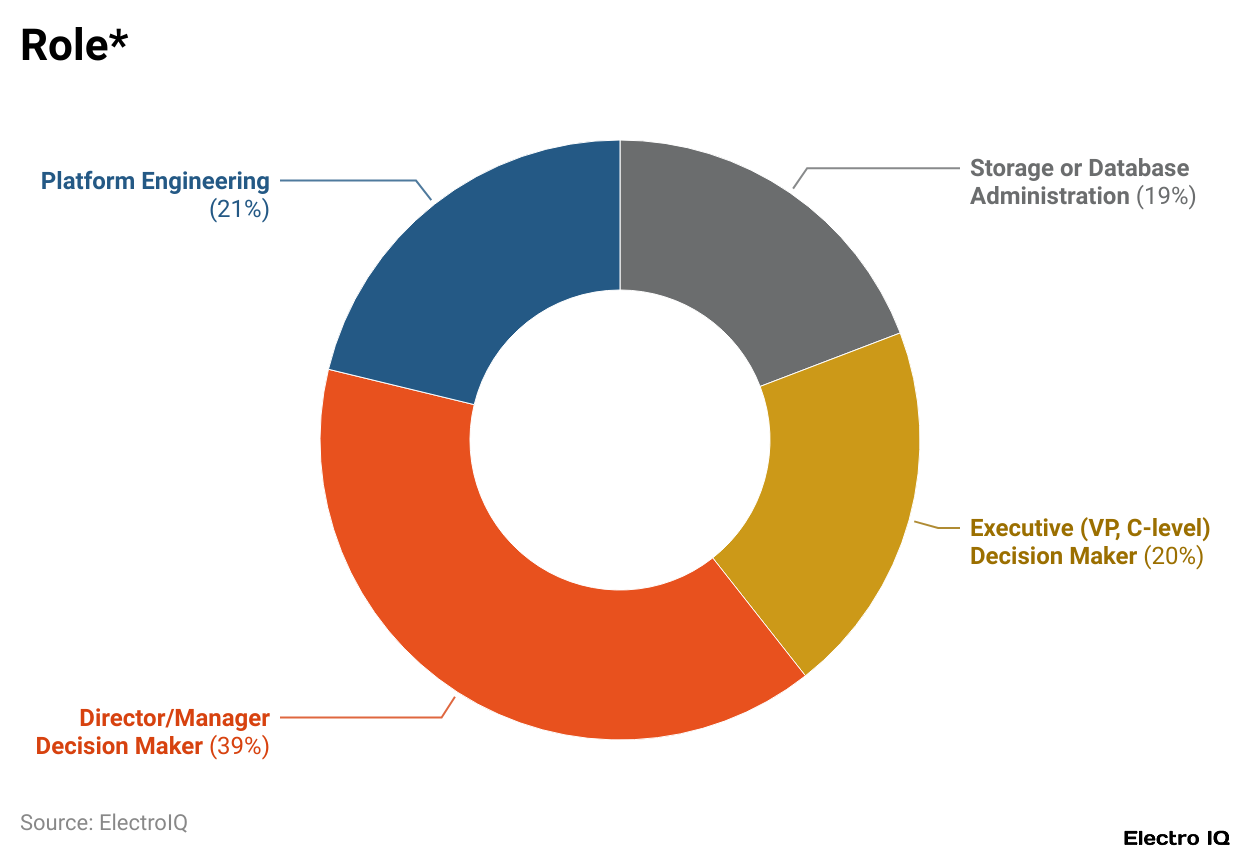
(Reference: portworx.com)
- The distribution of employee roles involved with Kubernetes shows how organisations spread responsibility for managing the platform across technical and decision-making functions.
- Directors and managers as decision makers represent the largest group at 39%.
- This suggests that mid- to senior-level management is heavily involved in the strategy, implementation, and governance of Kubernetes.
- Their participation shows that decisions regarding the use and scaling of Kubernetes can frequently be seen from a managerial standpoint, which sheds light on the weight Kubernetes holds in IT planning at large.
- Vice presidents and C-level executives make up 20% of decisions around Kubernetes. This further signifies that Kubernetes is not just a technical issue, but it is also a strategic concern at the highest organisational level.
- It can be said that these leaders discuss Kubernetes about digital transformation, operational efficiency, and return on investment.
- Platform engineering accounts for 21% of those working with Kubernetes. These are normally the technical experts who build and maintain the infrastructure sitting underneath Kubernetes.
- Storage and DBAs would make up 19% of Kubernetes roles, transitioning the landscape of managing persistent data and integrating databases in the context of containerized apps.
Kubernetes Technologies
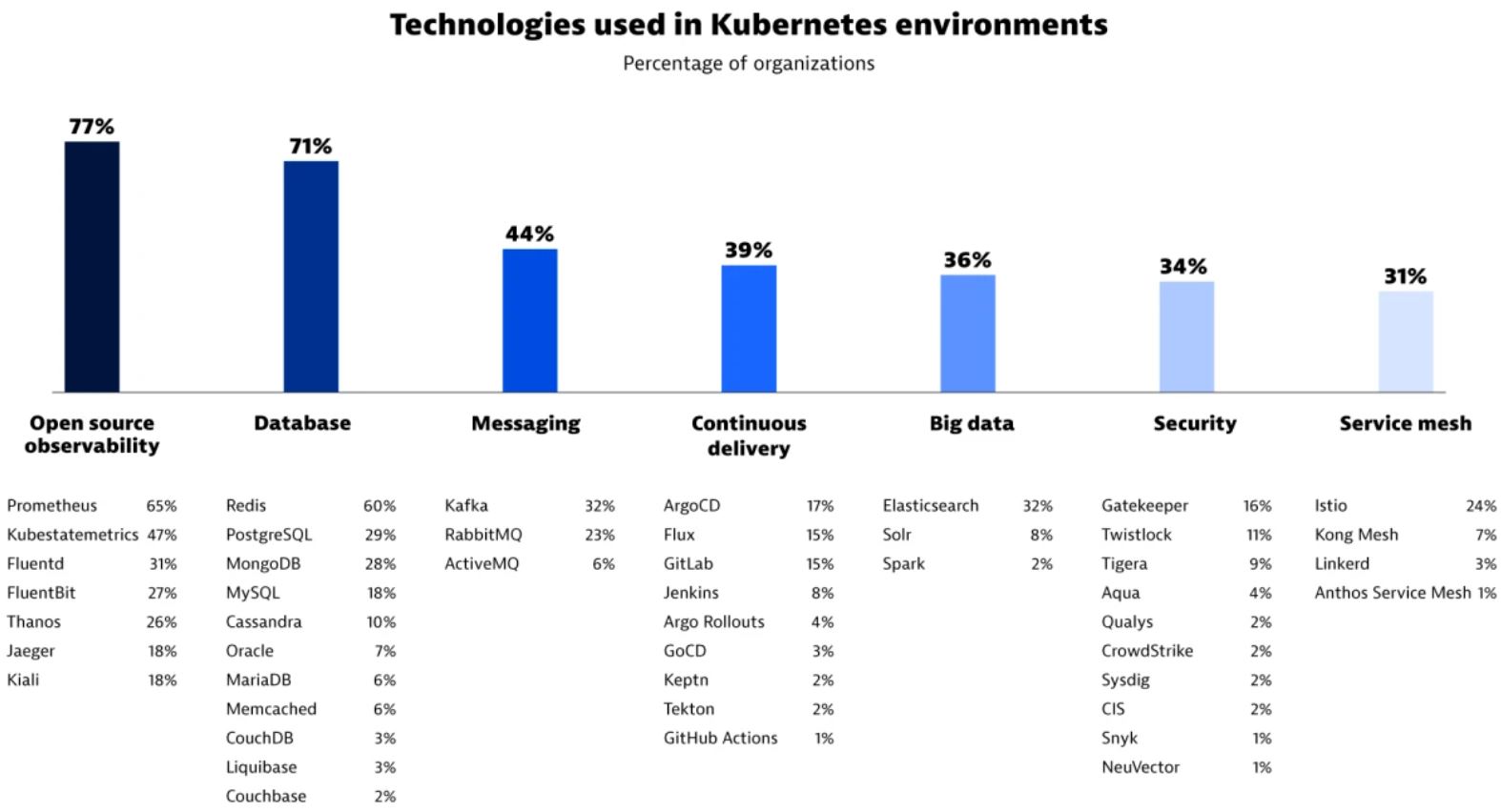
(Source: dynatrace.com)
- As per dynatrace.com/news, Kubernetes statistics show that the technology stack built or used with Kubernetes exemplifies the broad ecosystem supporting containerized applications.
- Observability tools dominate the spectrum, with 77% of respondents claiming that they use such observability tools in their systems.
- This high percentage informs the critical nature of monitoring, logging, and tracing in application environments rendered dynamic and distributed by Kubernetes.
- One has to keep an eye on how performance and behaviour manifest across systems to ensure uptime and timely troubleshooting.
- Databases are employed by 71% of Kubernetes users, which is expected, given that most applications will need to store and retrieve data.
- Managing the integration of databases and Kubernetes is important in managing both stateless and stateful entities efficiently in an automated and scalable environment.
- Messaging systems used by 44% of companies enable communication between services—the microservices communication layer.
- Through these, coordination and flow of data are assured between different areas of an application. Continuous delivery is practised by 39% of users, reinforcing the principles of automation and speed in modern software development.
- These tools enable developers to push updates more often and more reliably, combining well with DevOps cultures.
- Big data technologies are used by 36% of respondents, pointing to the increase of Kubernetes in supporting data-heavy workloads.
- This covers managing analytics, machine learning, and large-scale data processing pipelines requiring a flexible and scalable infrastructure.
- There has been a slight discrepancy among the sectors on the adoption of Kubernetes tools; 34% of the respondents are working on adopting security tools, signaling increased awareness toward protecting Kubernetes environments. Lastly, 31% of Kubernetes users implement service meshes.
- These tools are used to manage service-to-service communication, providing advanced features like traffic control, encryption, and observability at the networking level.
Kubernetes Education And Certification Growth
- The last year has seen an escalation in Kubernetes-related courses and certifications, showing that the cloud-native skills and professional credentials are increasingly needed by the marketplace.
- As per the Cloud Native Computing Foundation report on Kubernetes statistics, the number of participants in the Kubernetes MOOC increased by 25%, bringing the total enrollment to 290,000. This is a clear statement of interest in learning the Kubernetes basics through free and available online education.
- The Certified Kubernetes Administrator (CKA) exam rose spectacularly by 49% to 104,000 total enrollments.
- Such a jump in interest shows that the majority of people seeking formal credentialing for managing Kubernetes clusters have this requirement placed before them by companies wanting DevOps and cloud engineers.
- Similarly, registrations for the Certified Kubernetes Application Developer (CKAD) rose 44% to 49,000, which implies an acute interest among developers to certify their skills in architecting and deploying applications on Kubernetes.
- The most staggering jump was witnessed by the Certified Kubernetes Security Specialist (CKS) with a shocking 113% growth to 18,000 registrations.
- There is an elevated consideration for container applications and infrastructure, while security remains a matter of great concern in Kubernetes environments.
- The exam suite named Kubernetes and Cloud Native Associate (KCNA) was launched in November 2021 with 4,000 registrations.
- It is still relatively new but is emerging as the entry-level credential for those embarking on their Kubernetes journey.
- Kubernetes statistics show that on the training infrastructure side, the Kubernetes Training Partner (KTP) program grew by 14%, thereby increasing the overall count of KTPs past the 60 mark, meaning that more entities are available now to conduct official Kubernetes training.
- Lastly, the Kubernetes Certified Service Provider (KCSP) program, which certifies companies that provide elite-level support for Kubernetes, grew by 8.5% to include 254 companies.
Kubernetes Security Common Mistakes
- The Fairwinds Security, Cost, and Reliability Workload Results report on Kubernetes statistics analyzed data from more than 150,000 workloads across hundreds of companies with the Fairwinds Insights platform and found worrisome trends that suggest a decline in Kubernetes security.
- One major issue noted is the continued use of dangerous Linux capabilities like CHOWN, DAC_OVERRIDE, FSETID, and FOWNER.
- These capabilities are generally allowed by default, even though most workloads do not require them. In 2022, only 10% of companies disabled these capabilities, which marks an abrupt fall from 42% in 2021.
- Additionally, roughly one-third of organisations are running almost all of their workloads in an insecure configuration.
- Certain protective configurations, like allowPrivilegeEscalation, which could secure the cluster better, are, however, not available with the default setting.
- Around 44% of the organisations are running over 71% of their workloads as root, weighing up to a 22% increase since last year.
- Furthermore, this risk has greatly risen, with 62% of the organisations having at least half of their workloads at risk from image vulnerabilities.
- In 2022, 46% of companies stated that half or more of their workloads were running on Helm charts that had outdated versions, as compared to 33% of the companies in the year prior.
- There seems to be an increasing problem regarding the keeping of deployments updated and secure. Another serious concern is managing privileges.
- Kubernetes statistics data from Sysdig further states that 90% of privileges granted are never used, irrespective of the emphasis placed on cloud security and zero trust principles.
Conclusion
Kubernetes Statistics 2024 has emerged as an essential backbone of IT infrastructure, firmly entrenched in the industry. While Kubernetes offers tremendous advantages in terms of scalability and flexibility, it comes with the respective challenges having to do with security, complexity, and operational management.
As the environment continues to develop, organisations now invest in managed services, platform engineering, and advanced tooling to capture the value promised by Kubernetes as deeply as possible. In the forthcoming years, we expect further consolidation and innovation that will shape the future of cloud-native technologies.
FAQ.
Almost every country in the world has witnessed the adoption of Kubernetes, with the United States accounting for 52.4% of users. Other countries with a keen adoption mindset towards Kubernetes are India, Germany, the UK, Brazil, Canada, and France, with each ranging between 4.6% and 11.1%. This demonstrates that Kubernetes is gracing the international arena as an appealing IT infrastructure.
Mostly, it is adopted in larger and mid-sized enterprises, with 91% of its users emanating from organisations with over 1,000 employees. Inside those companies, Directors and managers make up 39% of decision-makers, while 20% are C-level executives, which gives the technology strategic significance; infrastructure-wise, platform engineers (21%) and storage/database admins (19%) play a very important role in managing Kubernetes environments.
The Kubernetes market is presently witnessing rapid expansion. It was valued at about US$1.46 billion in 2021, grew to over US$1.8 billion in 2022, and is expected to hit US$9.69 billion in 2031. The Kubernetes security market, meanwhile, is anticipated to grow at a CAGR of 27.6%, reaching US$10.7 billion by 2031. On the flip side, growth is enabled by the increased adoption of cloud-native architecture, container orchestration, automated deployment, and scaling.
Security is becoming a hot topic for Kubernetes: Only 10% of companies disabled risky Linux capabilities in 2022 (down from 42% in 2021). 44% of organisations run over 71% of workloads as root, increasing risk. 62% have image-related vulnerabilities in half or more of their workloads. 46% have out-of-date Helm charts installed, and 90% of cloud privileges that are granted go unused–a clear sign of severe misconfigurations and gaps in access control.
Kubernetes training and certification are in a boom: Kubernetes MOOC enrollments amounted to 290,000, with an increase of 25%. Certified Kubernetes Administrator (CKA) exam enrollments shot up by 49% to 104,000. Certified Kubernetes Application Developer (CKAD) and Security Specialist (CKS) exams rose 44% and 113%, respectively.

Barry Elad is a passionate technology and finance journalist who loves diving deep into various technology and finance topics. He gathers important statistics and facts to help others understand the tech and finance world better. With a keen interest in software, Barry writes about its benefits and how it can improve our daily lives. In his spare time, he enjoys experimenting with healthy recipes, practicing yoga, meditating, or taking nature walks with his child. Barry’s goal is to make complex tech and finance information easy and accessible for everyone.










